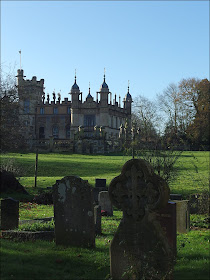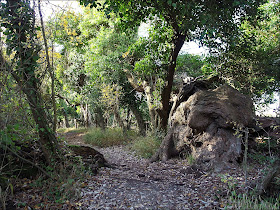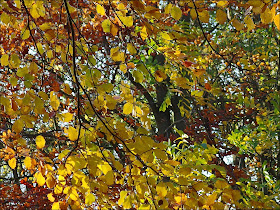Today, Friday, I went for a walk in the grounds of Knebworth House in Hertfordshire, a place where such diverse personalities as Winston Churchill and Freddie Mercury have strutted their stuff (the former - a friend of the well-connected Lytton family who owned the house for centuries, the latter - at one of the many outdoor rock festivals which have helped pay for the upkeep of the mansion in recent decades). The house is closed for the winter but the footpaths through the grounds are still open.
I'll show you some more of the walk in the next post but for now I'd like to tell you a little about some of the Lyttons. The house hasn't always looked like this; part of the old house is in there somewhere but the fantastic concoction we see today is the result of Victorian renovations carried out for Elizabeth Bulwer-Lytton, whom a biographer once described as "that odd rich old woman". Besides the fantastical appearance of her abode she also carried out a lifelong argument with the vicar of the church which stands just a short distance away in the grounds.
Whatever the cause of the disagreement it led to her banning her own employees (most of the local people) from attending church. She even carried on the argument from beyond the grave as she had a mausoleum built on her own property rather than being interred in the churchyard with her ancestors.
Whatever her other failings, her son Edward was greatly affected by his mother's death and ordered that her room must be preserved as it was at her death - and it's little changed to this day. Not that he was immune to his mother's quarrelsome temperament; when he married in 1827 she disapproved of the match and withdrew his allowance, forcing him to work for a living. He worked tirelessly at a writing career as well as being a politician but, despite considerable success in both careers, their extravagant lifestyle put the marriage under stress and the couple separated.
He wrote novels, plays and poetry in a wide variety of genres and though his work is largely forgotten today in his day he was regarded as one of England's foremost writers, he was as famous in his day as the young writer who came to visit in later years - Charles Dickens, no less.
Even if you've never heard of Bulwer-Lytton's writing, you'll know some of the phrases which he introduced into the language - "the great unwashed", "pursuit of the almighty dollar" and "the pen is mightier than the sword" are all his. He also began one novel "It was a dark and stormy night...." and that has inspired not only Snoopy but also an annual competition for bad writing.
His wife - or rather his ex-wife - Rosina Bulwer Lytton also published a novel, "Cheveley, or the Man of Honour" which harshly lampooned her former husband. Then when he stood for parliament she spoke out against him with such venom that he had her committed to a lunatic asylum. Public protests led to her release but she continued her campaign against him for the rest of his days.
The couple had two children, one of whom, Robert Bulwer-Lytton, went on to become Viceroy of India. He and his wife Edith had five children who survived to adulthood, and it's their second daughter, Lady Constance Georgina Bulwer-Lytton, who is probably the most interesting.
She was born in Vienna, then spent her early years in India before coming to the family home at Knebworth. She rejected the aristocratic lifestyle and became reclusive. When she inherited £1,000 she gave it to Mary Neal's Esperance Club for working-class girls from London's East End. Through this connection she got to know many of the Suffragettes who were conducting a militant campaign to gain women the right to vote.
At first she was very much against the violent protests of the Suffragettes, but was eventually persuaded that no other course of action would be effective. In 1909 she was imprisoned twice for throwing stones at Lloyd George's car, but the authorities released her when they realised that she was the daughter of the former Viceroy of India and had a brother in the House of Lords. While in jail she self-mutilated cutting the letter "V" into her chest. She had intended to carve the words "Votes For Women", from her chest to her face, but was prevented from doing so by the prison guards. Upon her release she wrote letters complaining of the inequality of treatment for persons of differing backgrounds.
The following year she rejoined the Suffragettes under the name Jane Warton, had her hair cut in an unflattering style and dressed in dowdy clothes. She then deliberately got herself arrested again and joined the hunger strikes, which imprisoned Suffragettes were using to protest at the way in which they were being treated as criminals rather than political prisoners. This time the prison had no idea that they were dealing with a member of the aristocracy and she was brutally force fed. Upon her release she wrote of the mistreatment she had received and though some MPs disbelieved her story they were quickly countered by her brother. Shortly afterwards she had a heart attack and several strokes which affected one side of her body. Undaunted she wrote an influential book on prison reform with her other hand.
When the Suffragettes ceased their militant campaign at the outbreak of the First World War she lent her support to Marie Stopes and her fight to establish birth control clinics. As her health declined further she went to live with her mother at Homewood, a house on the Knebworth estate surrounded on three sides by woodland but with views out over farmland. She died aged just 54 and lies in the family mausoleum built for her disputatious great grandmother.
Take care.























































